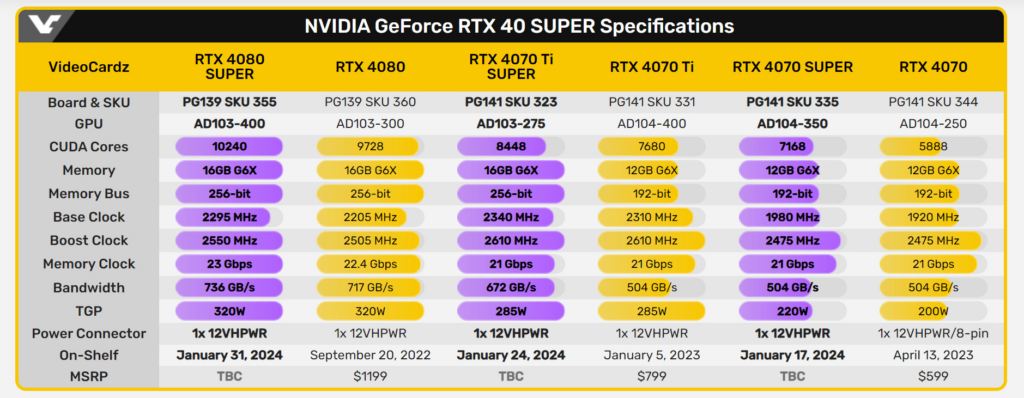RTX 40xx Super. Only the RTX 4070 Ti Super will see an increase in memory.

The website VideoCardz has published a complete list of specifications for the NVIDIA GeForce RTX 40 Super generation graphics cards. The lineup will include RTX 4070 Super, RTX 4070 Ti Super, and RTX 4080 Super.
Notably, only one graphics card will receive more memory — the RTX 4070 Ti Super (an additional 4 GB). The GeForce RTX 4070 Super’s GPU will consume more energy (by 10%).

VideoCardz notes that the specifications of the NVIDIA GeForce RTX 40 Super series have been confirmed. The RTX 4070 Super, RTX 4070 Ti Super, and RTX 4080 Super graphics cards are expected to be unveiled on January 17, 24, and 31, 2024, respectively.
On December 25, the first images of the GeForce RTX 4070 Super from ASUS appeared online. Rumors suggest the new model will feature 12 GB of memory, an AD104-G350 processor with 7169 CUDA cores, and a 12-pin power connector.
NVIDIA’s Next Leap: RTX 5000 Series Set for Launch Next Year
The NVIDIA GeForce RTX 4070 Ti SUPER is an enthusiast-class graphics card that boasts several impressive specifications:
- Manufacturing Process and GPU Architecture: It is built on a 5 nm process and is based on the AD103 graphics processor, in its AD103-275-A1 variant, supporting DirectX 12 Ultimate.
- Memory: The card is expected to feature 16 GB of VRAM, upgrading from the typical 12 GB found in the standard RTX 4070 models. This memory is GDDR6X type, with a 256-bit memory bus width.
- Cores and Cache: It will likely be equipped with 8448 CUDA cores, which are essential for parallel processing tasks in graphics rendering. Additionally, it’s expected to have a 48 MB L2 cache, enhancing its data retrieval speeds and overall performance.
These specifications indicate that the RTX 4070 Ti SUPER would be a significant upgrade over its non-SUPER counterpart, offering more memory, a higher number of CUDA cores, and a larger cache. This makes it well-suited for demanding gaming applications, high-resolution video editing, and complex 3D rendering tasks.
NVIDIA’s Next Leap: RTX 5000 Series Set for Launch Next Year


